逻辑回归
文中所用到的图片部分截取自Andrew Ng在Cousera上的课程
逻辑回归
上一节的线性回归可以看到,回归问题在数学上来说是建立$y$与$x$之间关系的模型,给定一个点集,能够用一条曲线去拟合之,如果这个曲线是一条直线,那就被称为线性回归,如果曲线是一条二次曲线,就被称为二次回归,回归还有很多的变种,等等。如果得到的预测函数得出的结果是离散的,我们把这种学习问题叫做分类问题。逻辑回归经常用于解决分类问题, 比如Email是否为Spam/非Spam, 肿瘤是否为恶性/良性,可用下面式子表达
\[y ∈ {0,1}\]对于分类场景,使用线性回归模型不适合,原因是 $h_{\theta}(x)$ 值不能保证只有0或1,因此我们需要对线性模型做一些改进。
Sigmoid函数
在给出模型前,我们先假设$y$的取值是连续的,则对于任意的输入有
\[0≤h_{\theta}(x)≤1\]为了达到这个目的,我们需要一个非线性函数$g(x)$将$h_{\theta}(x)$的输出映射到0和1之间,即$h_{\theta}(x)=\theta^{T}x$ 做如下变换:$h_{\theta}(x)=g(\theta^{T}x)$, 其中$g$为
可以得到$g(x)$的函数曲线如下

我们看到函数$g(x)$ 将所有实数映射到了(0,1]空间内, 则$g(z)$ 也叫做Sigmoid Function。
Linear Decision Boundary
通过观察函数曲线可以发现,当z大于 0 的时候g(z)≥0.5,因此只需要判断$\theta^{(T)}x$和0的关系即可:
- $\theta^{(T)}x ≥ 0$ 可推出 $y=1$
- $\theta^{(T)}x < 0$ 可推出 $y=0$
举个例子,假设有一个二维线性预测函数为
\[h_{\theta}(x) = g(\theta_0 + \theta_1x_1 + \theta_2x_2)\]现在假设θ值已确定为[-3,1,1],则问题变为求如果要y=1,那么需要 $h(x) = -3 + x_1+x_2 ≥ 0$, 即找到$x_1$, $x_2$满足 $x_1 + x_2 ≥ 3$,如下图所示:
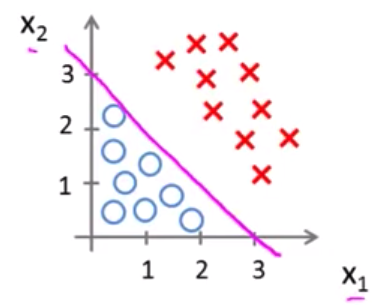
由上图可看出, 图中的粉色线段为可以作为Decision Boundary。当$x_1 + x_2 ≥ 3$时预测结果$y=1$,反之,当$x_1 + x_2 < 3$时,预测结果$y=0$
Non-linear Decision Boundary
接下来我们看一个非线性的预测函数,例如:
\[h_{\theta}x = g(\theta_0 + \theta_1x_1 + \theta_2x_2 + \theta_3x_1{^2} + \theta_4x_2{^2})\]假设θ值已经确定为[-1,0,0,1,1],同上,变为求如果要y=1,那么需要$-1 + x_1{^2} + x_2{^2} ≥ 0$,即找到$x_1$, $x_2$满足$x_1^2 + x_2^2 ≥ 0$,则边界函数为$x_1^2 + x_2^2 = 0$,如下图所示
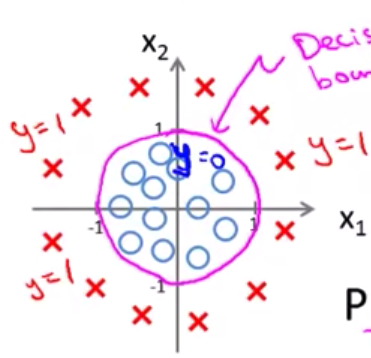
处于粉色圆圈内的样本点预测结果为0, 对于落在圈外的样本点,则预测结果为1。因此这种边界称为非线性的Decision Boundary
Cost Function
可以看到,所谓的逻辑回归,就是通过sigmoid函数将某个预测函数(可能是非线性函数)的值域限定在某个区域内,从而达到对输出进行分类的效果。 因此当我们有了模型以后,接下来的问题便是找到一个代价函数来求解θ值,如果使用之前现行回归的 cost function,即
由于$h(x)$变成了复杂的非线性函数,这时会出现$J(\theta)$存才多个local minimum的情况,即$J(\theta)$不是一个convex function,因此梯度下降无法得到最小值。因此我们要找到一个新的代价函数
\[Cost(h_\theta(x),y) =\begin{cases}-log(h_\theta(x)), & \text{if $y=1$} \\-log(1-h_\theta(x)), & \text{if $y=0$}\end{cases}\]当y=1的时候,J(θ) = 0 -> h(x)=1;J(θ) = ∞ -> h(x)=0,如下图所示
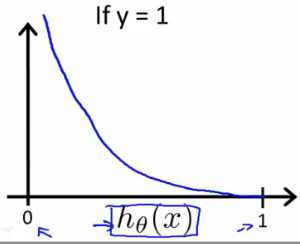
当y=0的时候,J(θ) =0 -> h(x)=0,J(θ) = ∞ -> h(x)=1,如下图所示
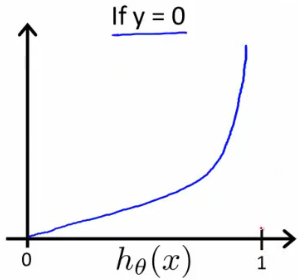
图上可以看出J(θ)有极值点,接下来的问题就是分别求解h(x)=0和h(x)=1两种情况下的θ值
Simplifed Cost Function
上述 Cost Function 可以简化为一行:
\[Cost(h_\theta(x),y) = -y\log(h_\theta(x)) - (1-y)\log(1-h_\theta(x))\]之所以将上述式子简化为一行,其目的是方便使用概率论中的最大似然估计求解,接下来还是通过梯度下降法求解$\theta$,是cost函数最小。我们另$J(\theta)$等于
\[J(\theta) = -\frac{1}{m}\sum_{i=1}^{m}[(y^{(i)}\log{(h_{(\theta)}(x^{(i)}))} + (1-y^{(i)})\log{(1-h_{(\theta)}(x^{(i)}))} ]\]向量化的实现为:
\[J(\theta) = \frac{1}{m}\cdot (-y^{(T)}log(h) - (1-y)^{(T)}log(1-h))\]Gradient Descent
前面可知梯度下降公式为:
\[\text{Repeat} \quad \{\] \[\quad \theta_j := \theta_j - \alpha \frac{\partial J(\theta)}{\partial \theta_j}\] \[\}\]对 $J(\theta)$ 求偏导,得到梯度下降公式:
\[\text{Repeat} \quad \{\] \[\quad \theta_j := \theta_j - \frac{\alpha}{m} \sum_{i=1}^{m} \left( h_{\theta}(x^{(i)}) - y^{(i)} \right) x_j^{(i)}\] \[\}\]注意到上述公式和线性回归使用的梯度下降公式相同,不同的是h(θ),上述公式向量化表示为:
Advanced Optimization
对于求解 $J(\theta)$ 的最小值,目前的做法是使用梯度下降法,对θ求偏导,除了梯度下降之外,还有其它几种优化算法:
- Conjugate gradient
- BFGS
- L-BFGS
这三种算法的优点是:
- 不需要人工选择
α - 比低度下降更快
缺点是:比较复杂
开发者不需要自己实现这些算法,在一般的数值计算库里都有相应的实现,例如 python,Octave 等。我们只需要关心两个问题,如何给出:
\[J(\theta)\] \[\frac{\partial J(\theta)}{\partial \theta_j}\]我们可以使用 Octave 写这样一个函数:
function [jVal, gradient] = costFunction(theta)
jVal = [...code to compute J(theta)...];
gradient = [...code to compute derivative of J(theta)...];
end
然后使用 Octave 自带的fminunc()优化算法计算出θ的值:
options = optimset('GradObj', 'on', 'MaxIter', 100);
initialTheta = zeros(2,1);
[optTheta, functionVal, exitFlag] = fminunc(@costFunction, initialTheta, options);
fminunc()函数接受三个参数:costFunction,初始的 θ 值(至少是 2x1 的向量),还有 options
Multiclass classification
前面我们解决的问题都是针对两个场景进行分类,即 y = {0,1} 实际生活中,常常有多个场景需要归类,例如
- Email foldering/tagging:Work,Friends,Family,Hobby
- Weather:Sunny,Cloudy,Rain,Snow
即分类结果不只是 0 或 1,而是多个 y = {0,1…n},解决多个分类我们使用 one-vs-all 的方式,即选取某一个场景进行归类时,将其他场景合并为起对立的场景。如图:
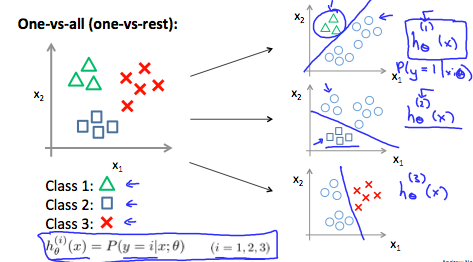
上图可知我们先取一个 class 进行计算,将其他的归类为另一个 class,这样就可以使用前面提到的 binary regression model 进行计算,即
\[y \in \{0, 1, \dots, n\}\] \[h_{\theta}^{(0)}(x) = P(y = 0 \mid x; \theta)\] \[h_{\theta}^{(1)}(x) = P(y = 1 \mid x; \theta)\] \[\vdots\] \[h_{\theta}^{(n)}(x) = P(y = n \mid x; \theta)\] \[\text{prediction} = \arg\max_i \, h_{\theta}^{(i)}(x)\]- One-vs-all(one-vs-rest):
Train a logistic regression classifier $h_{\theta}^{(i)}(x)$ for each class $i$ to predict the probability that $y = i$. On a new input $x$, to make a prediction, pick the class $i$ that maximizes
总结一下,就是对每种分类先计算它的 $h_{\theta}(x)$,当有一个新的 x 需要分类时,选择使 $h_{\theta}(x)$ 值最大的分类器。
附录:Regularization
The problem of overfitting
以线性回归的预测房价为例,如下图所示:

可以看到:
- 通过线性函数预测房价不够精确(underfit),术语叫做”High Bias”,其原因主要是样本的 feature 太少了。
- 通过二次函数拟合出来的曲线刚好可以贯穿大部分数据样本,术语叫做”Just Right”
-
通过四阶多项式拟合出来的曲线虽然能贯穿所有数据样本,但是曲线本身不够规则,当有新样本出现时不能很好的预测。这种情况我们叫做Over Fitting(过度拟合),术语叫做”High variance”。If we have too many features, the learned hypothesis may fit the training set very well(
J(θ)=0), but fail to generalize to new examples(predict prices on new examples) Over Fitting 的问题在样本少,feature 多的时候很明显 - Addressing overfitting:
- Reduce number of features
- Manually select which features to keep
- Model selection algorithm
- Regularization
- Keep all features, but reduce magnitude/values of parameters $ \theta_j $
- Works well when we have a lot of features, each of which contributes a bit to predicting $ y $
- Reduce number of features
Regularization Cost Function
如果要减少 overfitting 的情况,我们可以降低一些参数的权重,假设我们想要让下面的函数变成二次方程:
\[\theta_0 + \theta_1 x + \theta_2 x^2 + \theta_3 x^3 + \theta_4 x^4\]我们想要在不去掉 $\theta_3$ 和 $\theta_4$ 的前提下,降低 $\theta_3 x^3$ 和 $\theta_4 x^4$ 的影响,我们可以修改 cost function 为:
\[\min_{\theta} \frac{1}{2m} \sum_{i=1}^{m} \left( h_{\theta}(x^{(i)}) - y^{(i)} \right)^2 + 1000 \cdot \theta_3^2 + 1000 \cdot \theta_4^2\]我们在原来的 cost function 后面增加了两项,为了让 cost function 接近 0,我们需要让 $\theta_3, \theta_4$ 近似为 0,这样即会极大地减少 $\theta_3 x^3$ 和 $\theta_4 x^4$ 的值,减少后的曲线如下图粉色曲线,更接近二次函数:
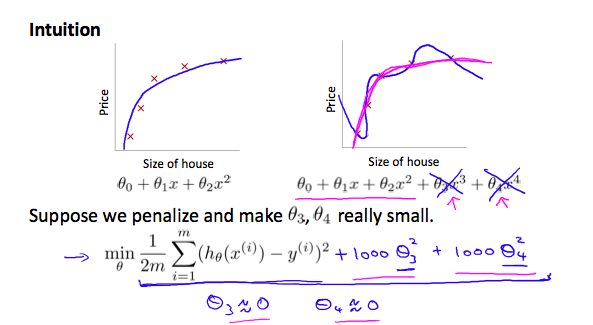
Small values for parameters $\theta_0, \theta_1, \dots, \theta_n$
- “Simpler” hypothesis,选取更小的
θ值能得到更简单的预测函数,例如上面的例子,如果将 $\theta_3, \theta_4$ 近似为 0 的话,那么上述函数将变为二次方程,更贴近合理的假设函数。 - Housing example:
- Feature: $x_0, x_1, \dots, x_{100}$
- Parameters: $\theta_0, \theta_1, \dots, \theta_{100}$
100 个 feature,如何有效的选取这些θ呢,改变 cost function:
参数 $\lambda$ 叫做 regularization parameter,它的作用是既要保证曲线的拟合程度够高,同时又要确保 $\theta$ 的值尽量小。如果 $\lambda$ 的值选取过大,例如 $\lambda = 10^{10}$,会导致计算出的所有 $\theta$ 值都接近 0,从而使 $h_{\theta}(x) = \theta_0$,即产生 “Underfitting”。
Regularized linear regression
有了上面的式子,我们可以将它应用到线性回归:
- 修改梯度下降公式为:
将 $\frac{\lambda}{m} \theta_j$ 提出来,得到:
\[\theta_j := \theta_j \left( 1 - \alpha \frac{\lambda}{m} \right) - \alpha \frac{1}{m} \sum_{i=1}^{m} \left( h_{\theta}(x^{(i)}) - y^{(i)} \right) x_j^{(i)}\]上述式子中 $1 - \alpha \frac{\lambda}{m}$ 必须小于 1,这样就减小了 $\theta_j$ 的值,后面的式子和之前梯度下降的式子相同。
- 应用到 Normal Equation
和之前的公式相比,增加了一项:
\[\theta = \left( X^T X + \lambda \cdot L \right)^{-1} X^T y\]where
\[L = \begin{bmatrix} 0 & & & & \\ & 1 & & & \\ & & 1 & & \\ & & & \ddots & \\ & & & & 1 \end{bmatrix}\]$L$ 是一个 $(n+1) \times (n+1)$ 的单位矩阵,第一项是 $0$。在引入 $\lambda L$ 之后,$X^T X + \lambda L$ 保证可逆。
Regularized logistic regression
逻辑回归也有 overfitting 的问题,如图所示
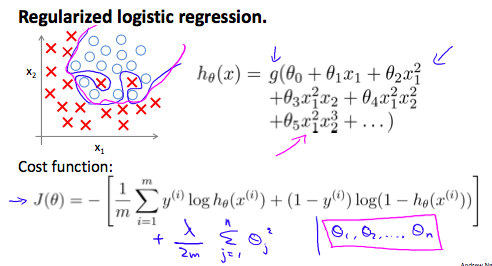
处理方式和线性回归相同,之前知道逻辑回归的 cost function 如下:
\[J(\theta) = - \frac{1}{m} \sum_{i=1}^{m} \left[ y^{(i)} \log h_{\theta}(x^{(i)}) + (1 - y^{(i)}) \log (1 - h_{\theta}(x^{(i)})) \right]\]我们可以在最后加一项来 regularize 这个函数:
\[J(\theta) = - \frac{1}{m} \sum_{i=1}^{m} \left[ y^{(i)} \log h_{\theta}(x^{(i)}) + (1 - y^{(i)}) \log (1 - h_{\theta}(x^{(i)})) \right] + \frac{\lambda}{2m} \sum_{j=1}^{n} \theta_j^2\]第二项:$\sum_{j=1}^{n} \theta_j^2$ 是排除了 $\theta_0$ 的,因此,计算梯度下降要对 $\theta_0$ 单独计算:
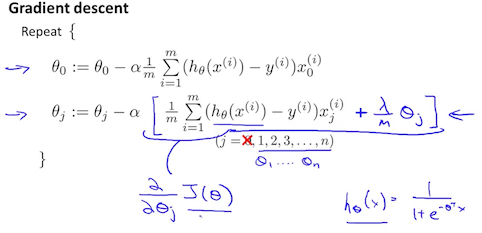
- Octave Demo
function [J, grad] = lrCostFunction(theta, X, y, lambda{
%LRCOSTFUNCTION Compute cost and gradient for logistic regression with
%regularization
% J = LRCOSTFUNCTION(theta, X, y, lambda) computes the cost of using
% theta as the parameter for regularized logistic regression and the
% gradient of the cost w.r.t. to the parameters.
% Initialize some useful values
m = length(y); % number of training examples
% You need to return the following variables correctly
J = 0;
grad = zeros(size(theta));
h = sigmoid(X*theta); % X:118x28, theta:28x1 h:118x1
%向量化实现
J = 1/m * (-y'*log(h)-(1-y)'*log(1-h)) + 0.5*lambda/m * sum(theta([2:end]).^2);
%代数形式实现
%J = 1/m * sum((-y).*log(h) - (1-y).*log(1-h)) + 0.5*lambda/m * sum(theta([2:end]).^2);
grad = 1/m * X'*(h-y);
r = lambda/m .* theta;
r(1) = 0; %skip theta(0)
grad = grad + r;
% =============================================================
grad = grad(:);
}
function g = sigmoid(z)
g = 1.0 ./ (1.0 + exp(-z));
end
